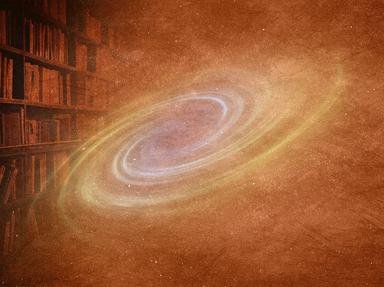Quiz Answer Key and Fun Facts
1. We return to the story of particle physics in 1964, when the famous quark model was proposed independently by George Zweig and Murray Gell-Mann. They explained the Eightfold Way by suggesting that the hadrons (composite particles like protons, neutrons and mesons) were composed of even smaller particles, which Gell-Mann called "quarks." From what James Joyce novel did he take that name?
2. There was a big problem with the quark model: the Pauli exclusion principle. Quarks are fermions and can never occupy the same quantum state, but some hadrons can only be constructed out of three quarks with identical quantum numbers. Later in 1964, Oscar Greenberg solved the problem by introducing what additional quantum number that can never be observed in the laboratory?
3. Even as the quark model was coming together, however, a cherished physical symmetry was dying. Physicists had been stunned when parity (P) was shown to be violated by the weak force in 1956, but they held out hope for CP symmetry. The idea was that the "mirror image" of a particle was its antiparticle: if you changed a particle to an antiparticle, and reflected it from left to right, then the physical laws would remain the same. Alas, this is not the case! In what strange mesons was CP violation discovered in 1964?
4. Theorists working with the strong and weak forces using the quark model soon found that they could make use of a clever type of diagram first introduced for quantum electrodynamics. They draw straight lines for fundamental particles (quarks and leptons), using arrows to indicate the forward time direction (antiparticle arrows are drawn backwards). Force-carrying bosons can be drawn using dashed or squiggly lines, and it is easy to calculate the cross section of a reaction by multiplying the contributions of the various lines and corners of the diagram. These useful diagrams are named after what famous American physicist, notorious for his practical jokes?
5. The quark model was not fully accepted until the autumn of 1974, when a pair of papers gave rise to the November Revolution. Groups at Brookhaven (in New York) and the Stanford Linear Accelerator (SLAC, in California) had independently discovered a new particle, now called the J/Psi, that provided evidence for what new flavor of quark?
6. Everything seemed to fall into place after the November Revolution. There were four quarks, there were four leptons, and all the hadrons could be arranged in three-dimensional "periodic tables." Then, in 1975, Martin Perl and his group at SLAC had to go and discover an unexpected fundamental particle. What was it?
7. Physicists soon began to make progress understanding the weak force, which changes the flavors of quarks and is responsible for beta decay (a type of radioactivity). Sheldon Glashow, Abdus Salam, and Steven Weinberg predicted that the weak force was mediated by three "intermediate vector bosons," the W+, W-, and Z. They reached this conclusion by unifying the weak force with what other force?
8. After Perl's discovery, particle physicists strongly suspected that there should be another quark. In 1977, a team at Fermilab found it. What is the name of this negatively-charged quark, the lightest of the third generation?
9. As discoveries of heavy mesons intensified, it became clear that -- despite the cleverness of Yukawa's 1930s ideas about the pi meson -- the strong force had to be mediated by something else. In 1979, at the DESY accelerator in Hamburg, Germany, that something else was discovered. What is the massless particle that mediates the strong or color force?
10. In 1998, the SuperKamiokande collaboration, a group of Japanese and American experimentalists, made a startling announcement. It has long been known that neutrinos come in three generations, or "flavors": electron, muon, and tau. But the SuperK results showed that neutrinos oscillate between flavors: over a long distance, a muon neutrino may become an electron neutrino, then back to a muon. What does this result imply?
Source: Author
CellarDoor
This quiz was reviewed by FunTrivia editor
crisw before going online.
Any errors found in FunTrivia content are routinely corrected through our feedback system.
